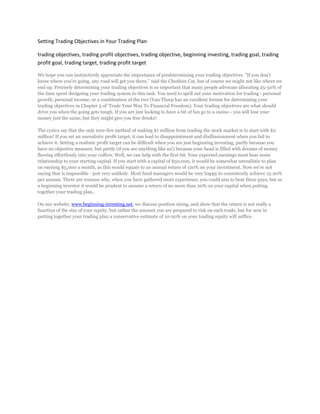
Trading Objectives - the Why and What of Your Trading Plan
- 1. Setting Trading Objectives in Your Trading Plan<br />trading objectives, trading profit objectives, trading objective, beginning investing, trading goal, trading profit goal, trading target, trading profit target<br />We hope you can instinctively appreciate the importance of predetermining your trading objectives. quot; If you don't know where you're going, any road will get you there,quot; said the Cheshire Cat, but of course we might not like where we end up. Precisely determining your trading objectives is so important that many people advocate allocating 25-50% of the time spent designing your trading system to this task. You need to spell out your motivation for trading - personal growth, personal income, or a combination of the two (Van Tharp has an excellent format for determining your trading objectives in Chapter 3 of 'Trade Your Way To Financial Freedom). Your trading objectives are what should drive you when the going gets tough. If you are just looking to have a bit of fun go to a casino - you will lose your money just the same, but they might give you free drinks!The cynics say that the only sure-fire method of making $1 million from trading the stock market is to start with $2 million! If you set an unrealistic profit target, it can lead to disappointment and disillusionment when you fail to achieve it. Setting a realistic profit target can be difficult when you are just beginning investing, partly because you have no objective measure, but partly (if you are anything like us!) because your head is filled with dreams of money flowing effortlessly into your coffers. Well, we can help with the first bit. Your expected earnings must bear some relationship to your starting capital. If you start with a capital of $50,000, it would be somewhat unrealistic to plan on earning $5,000 a month, as this would equate to an annual return of 120% on your investment. Now we're not saying that is impossible - just very unlikely. Most fund managers would be very happy to consistently achieve 15-20% per annum. There are reasons why, when you have gathered more experience, you could aim to beat these guys, but as a beginning investor it would be prudent to assume a return of no more than 20% on your capital when putting together your trading plan.. On our website, www.beginning-investing.net, we discuss position sizing, and show that the return is not really a function of the size of your equity, but rather the amount you are prepared to risk on each trade, but for now in putting together your trading plan a conservative estimate of 10-20% on your trading equity will suffice. <br />
